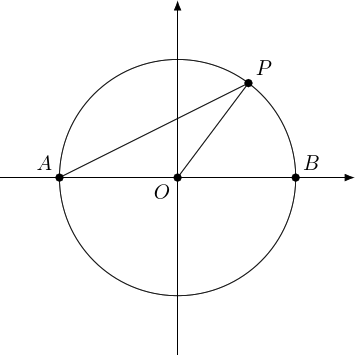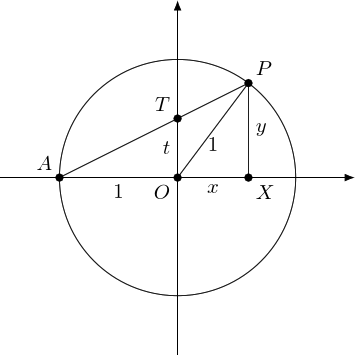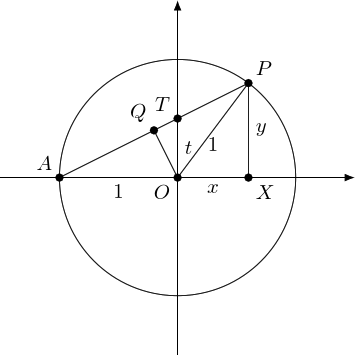1 Introduction
Two things juxtaposed for this post. The first was learning from Niles Johnson of a way to generate Pythagorean triples using lines and circles. The second was learning that there are concepts to learn in order to take GCSE Mathematics.
One thing in the post about Pythagorean triples was the occurrence of the formulae:
Now, it might just be the generation that I am, but I remember learning those formulae at school as how to write cosine and sine in terms of the tangent of the half angle. The formula book1 even made the substitution so that the formulae read:
1I can still visualise the page all these years later.
So when reading that post, I wondered if there were some way to exploit that relationship to simplify the argument.
I had a go at it, and found what I believe is such a simplification.
In doing that, I realised that yet again similar triangles are the key. Which brings me to those concepts. How many of them, I wonder, are just "similar triangles" dressed up in strange language?
2 Pythagorean Triples
Let's go through the first part of the search for Pythagorean triples. A Pythagorean triple, let's recall, is a set of three integers, say , , and , which satisfy Pythagoras' theorem:
This means that there is a right-angled triangle with integer sides.
Dividing through by yields:
and this means that are the coordinates of a point on the unit circle with the property that both coordinates are rational numbers.
Conversely, if is a point on the unit circle with both and rational, then we can put them over a common denominator and so write and , then as they are on the unit circle we have which untangles to .
So Pythagorean triples almost correspond to rational points on the unit circle. The "almost" is because if we multiply each number in a Pythagorean triple by the same constant then we get a new triple but they both give the same point on the unit circle. For example, and are different Pythagorean triples but and are the same point. We'll not bother about this.
In Niles Johnson's post, a diagram like Figure 1 appears.
In this, we can see the source of the half angle. The "angle at circumference is half angle at centre" rule leads to the conclusion that is half of . So we could use some trigonometry to figure out the coordinates of in terms of the tangent of the angle at , and once we had that we would have the formulae from Niles Johnson's post.
3 Similar Triangles
But trigonometry is just another name for similar triangles. So is there a way to use similar triangles directly?
The tangent of the angle at is the gradient of the line . Let's call this . This is the height that the line rises for every one unit we go across. As we go across one unit from to , the line must cross the –axis at height . So we can also think of as the –intercept of .
Our goal is the coordinates of . It's a common thing to do to draw a right-angled triangle to illustrate the coordinates of a point, so let's adorn our diagram with that triangle. Adding both of these new features, we end up with Figure 2.
There are two obvious similar triangles here: and . We could exploit this similarity together with the fact that lies on the circle to find the formulae for and . Pythagoras tells us that , while similarity says that . But then we need to substitute in and solve, which leads to a quadratic. This is Niles Johnson's approach.
We can do better.
There's another similar triangle. Let's "drop" the perpendicular from to . As triangle is isosceles (since ), this bisects . Figure 3 is the result.
Now is a right-angle and so triangle is similar to . What's a bit confusing here is that the triangles have been flipped, so the hypotenuse of is the base of . Similarity then says:
As bisects , and using , this means that:
Similarity also tells us that:
Substituting in and , we get:
Putting these together yields:
Finally, is the hypotenuse of the right-angled triangle so and we get:
And using similarity again tells us that which leads to:
and this rearranges to:
4 Rational Points
The purpose of this is that if then so also are and , meaning that the point has rational coordinates and we get a Pythagorean triple.
In fact, if we write , then
and
This fits our pattern with , , and , and thus this is our Pythagorean triple.
A bonus from this approach is that it shows that points in the unit circle with rational coordinates are dense. Pick a point on the circle with coordinates . Then join to . The slope of this line is . Now choose to be a rational approximation to . Then the resulting point is a rational approximation to lying on the unit circle.
And all from similar triangles!



